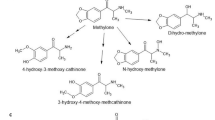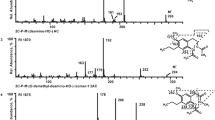Abstract
3,4-Methylenedioxymethamphetamine (MDMA) is an illicit phenethylamine ingested for entactogenic and euphoric effects. Although blood is more commonly submitted for forensic analysis, previous human MDMA pharmacokinetics research focused on plasma data; no direct blood–plasma comparisons were drawn. Blood and plasma specimens from 50 healthy adult volunteers (33 males, 17 females, 36 African-American) who ingested recreational 1.0 and 1.6 mg/kg MDMA doses were quantified for MDMA and metabolites 4-hydroxy-3-methoxymethamphetamine (HMMA), 3,4-methylenedioxyamphetamine (MDA), and 4-hydroxy-3-methoxyamphetamine (HMA) by two-dimensional gas chromatography–mass spectrometry. Specimens were collected up to 3 h post-dose and evaluated for maximum concentration (C max), first detection time (t first), time of C max (t max), and 3-h area under the curve (AUC0–3 h); as well as blood metabolite ratios and blood/plasma ratios. Median blood MDMA and MDA C max were significantly greater (p < 0.0005) than in plasma, but HMMA was significantly less (p < 0.0005). HMA was detected in few blood specimens, at low concentrations. Nonlinear pharmacokinetics were not observed for MDMA or MDA in this absorptive phase, but HMMA C max and AUC0–3 h were similar for both doses despite the 1.6-fold dose difference. Blood MDA/MDMA and MDA/HMMA significantly increased (p < 0.0001) over the 3-h time course, and HMMA/MDMA significantly decreased (p < 0.0001). Blood MDMA C max was significantly greater in females (p = 0.010) after the low dose only. Low-dose HMMA AUC0–3 h was significantly decreased in females’ blood and plasma (p = 0.027) and in African-Americans’ plasma (p = 0.035). These data provide valuable insight into MDMA blood–plasma relationships for forensic interpretation and evidence of sex- and race-based differential metabolism and risk profiles.

Median (interquartile range) blood/plasma 3,4-methylenedioxymethamphetamine (MDMA) (a), 4-hydroxy-3-methoxymethamphetamine (HMMA) (b), and 3,4-methylenedioxyamphetamine (MDA) (c) ratios for 3 h after controlled MDMA administration. Changes over time were significant after the 1.6 mg/kg dose for HMMA and MDA (p = 0.013 and p = 0.021), but not for MDMA. No changes over time were significant after the 1.0 mg/kg dose. Note: y-axes do not begin at 0. *p < 0.05 (low vs. high)



Similar content being viewed by others
References
Sumnall HR, Cole JC, Jerome L (2006) The varieties of ecstatic experience: an exploration of the subjective experiences of ecstasy. J Psychopharmacol 20(5):670–682
de la Torre R, Farre M, Roset PN, Lopez CH, Mas M, Ortuno J, Menoyo E, Pizarro N, Segura J, Cami J (2000) Pharmacology of MDMA in humans. Ann NY Acad Sci 914:225–237
Downing J (1986) The psychological and physiological effects of MDMA on normal volunteers. J Psychoactive Drugs 18:335–340
Cami J, Farre M, Mas M, Roset RN, Poudevida S, Mas A, San L, de la Torre R (2000) Human pharmacology of 3,4-methylenedioxymethamphetamine (“Ecstasy”): psychomotor performance and subjective effects. J Clin Psychopharm 20(4):455–466
Lacey JH, Kelley-Baker T, Furr-Holden D, Voas RB, Romano E, Ramirez A, Brainard K, Moore C, Torres P, Berning A (2009) 2007 National Roadside Survey of Alcohol and Drug Use by Drivers: Drug Results. National Highway Traffic Safety Administration Office of Behavioral Safety Research. http://www.nhtsa.gov/Driving+Safety/Research+&+Evaluation/2007+National+Roadside+Survey+of+Alcohol+and+Drug+Use+by+Drivers. Accessed 15 Aug 2013
Substance Abuse and Mental Health Services Administration (2010) Results from the 2009 National Survey on Drug Use and Health: National Findings NSDUH Series H-38A. Department of Health and Human Services (DHHS), Rockville, MD. http://www.samhsa.gov/data/2k9/2k9Resultsweb/web/2k9results.htm. Accessed 15 Aug 2013
Kolbrich EA, Goodwin RS, Gorelick DA, Hayes RJ, Stein EA, Huestis MA (2008) Plasma pharmacokinetics of 3,4-methylenedioxymethamphetamine after controlled oral administration to young adults. Ther Drug Monit 30(3):320–332
Meyer MR, Peters FT, Maurer HH (2008) The role of human hepatic cytochrome P450 isozymes in the metabolism of racemic 3,4-methylenedioxy-methamphetamine and its enantiomers. Drug Metab Dispos 36(11):2345–2354
Kolbrich EA, Goodwin RS, Gorelick DA, Hayes RJ, Stein EA, Huestis MA (2008) Physiological and subjective responses to controlled oral 3,4-methylenedioxymethamphetamine administration. J Clin Psychopharmacol 28(4):432–440
Farre M, de la Torre R, Mathuna BO, Roset PN, Peiro AM, Torrens M, Ortuno J, Pujadas M, Cami J (2004) Repeated doses administration of MDMA in humans: pharmacological effects and pharmacokinetics. Psychopharmacology (Berl) 173(3–4):364–375
Peiro AM, Farre M, Roset PN, Carbo M, Pujadas M, Torrens M, Cami J, de la Torre R (2013) Human pharmacology of 3,4-methylenedioxymethamphetamine (MDMA, ecstasy) after repeated doses taken 2 h apart. Psychopharmacology (Berl) 225(4):883–893
Ramaekers JG, Kuypers KP, Samyn N (2006) Stimulant effects of 3,4-methylenedioxymethamphetamine (MDMA) 75 mg and methylphenidate 20 mg on actual driving during intoxication and withdrawal. Addiction 101(11):1614–1621
Pizarro N, Farre M, Pujadas M, Peiro AM, Roset PN, Joglar J, de la Torre R (2004) Stereochemical analysis of 3,4-methylenedioxymethamphetamine and its main metabolites in human samples including the catechol-type metabolite (3,4-dihydroxymethamphetamine). Drug Metab Dispos 32(9):1001–1007
Mueller M, Peters FT, Huestis MA, Ricaurte GA, Maurer HH (2009) Simultaneous liquid chromatographic-electrospray ionization mass spectrometric quantification of 3,4-methylenedioxymethamphetamine (MDMA, Ecstasy) and its metabolites 3,4-dihydroxymethamphetamine, 4-hydroxy-3-methoxymethamphetamine and 3,4-methylenedioxyamphetamine in squirrel monkey and human plasma after acidic conjugate cleavage. Forensic Sci Int 184(1–3):64–68
Peters FT, Samyn N, Lamers CT, Riedel WJ, Kraemer T, de Boeck G, Maurer HH (2005) Drug testing in blood: validated negative-ion chemical ionization gas chromatographic-mass spectrometric assay for enantioselective measurement of the designer drugs MDEA, MDMA, and MDA and its application to samples from a controlled study with MDMA. Clin Chem 51(10):1811–1822
Desrosiers NA, Barnes AJ, Hartman RL, Scheidweiler KB, Kolbrich-Spargo EA, Gorelick DA, Goodwin RS, Huestis MA (2013) Oral fluid and plasma 3,4-methylenedioxymethamphetamine (MDMA) and metabolite correlation after controlled oral MDMA administration. Anal Bioanal Chem 405(12):4067–4076
Kolbrich EA, Lowe RH, Huestis MA (2008) Two-dimensional gas chromatography/electron-impact mass spectrometry with cryofocusing for simultaneous quantification of MDMA, MDA, HMMA, HMA, and MDEA in human plasma. Clin Chem 54:379–387
Scientific Working Group for Forensic Toxicology (SWGTOX) (2013) Standard practices for method validation in forensic toxicology. http://www.swgtox.org/documents/Validation3.pdf Acessed 15 Aug 2013
Scheidweiler KB, Barnes AJ, Huestis MA (2008) A validated gas chromatographic-electron impact ionization mass spectrometric method for methamphetamine, methylenedioxymethamphetamine (MDMA), and metabolites in mouse plasma and brain. J Chromatogr B 876(2):266–276
Helmlin H, Bracher K, Bourquin D, Vonlanthen D, Brenneisen R (1996) Analysis of 3,4-methylenedioxymethamphetamine (MDMA) and its metabolites in plasma and urine by HPLC-DAD and GC-MS. J Anal Toxicol 20:432–440
Clauwaert KM, Van Bocxlaer JF, DeLetter EA, Van Calenbergh S, Lambert WE, De Leenheer AP (2000) Determination of the designer drugs 3,4-methylenedioxymethamphetamine, 3,4-methylenedioxyethylamphatamine, and 3,4-methylenedioxyamphetamine with HPLC and fluorescence detection in whole blood, serum, vitreous humor, and urine. Clin Chem 46:1968–1977
Cheze M, Deveaux M, Martin C, Lhermitte M, Pepin G (2007) Simultaneous analysis of six amphetamines and analogues in hair, blood and urine by LC-ESI-MS/MS. Application to the determination of MDMA after low ecstasy intake. Forensic Sci Int 170(2–3):100–104
Middleberg RA, Homan J (2012) Quantitation of amphetamine-type stimulants by LC-MS/MS. Methods Mol Biol 902:105–114
Bjork MK, Nielsen MK, Markussen LO, Klinke HB, Linnet K (2010) Determination of 19 drugs of abuse and metabolites in whole blood by high-performance liquid chromatography-tandem mass spectrometry. Anal Bioanal Chem 396(7):2393–2401
da Silva DG, de Pinho PG, Pontes H, Ferreira L, Branco P, Remiao F, Carvalho F, Bastos ML, Carmo H (2010) Gas chromatography-ion trap mass spectrometry method for the simultaneous measurement of MDMA (ecstasy) and its metabolites, MDA, HMA, and HMMA in plasma and urine. J Chromatogr B 878(9–10):815–822
Tomita M, Nakashima MN, Wada M, Nakashima K (2007) Sensitive determination of MDMA and its metabolite MDA in rat blood and brain microdialysates by HPLC with fluorescence detection. Biomed Chromatogr 21(10):1016–1022
Jantos R, Veldstra JL, Mattern R, Brookhuis KA, Skopp G (2011) Analysis of 3,4-methylenedioxymetamphetamine: whole blood versus dried blood spots. J Anal Toxicol 35(5):269–273
Navarro M, Pichini S, Farre M, Ortuno J, Roset PN, Segura J, de La Torre R (2001) Usefulness of saliva for measurement of 3,4-methylenedioxymehamphetamine and its metabolites: correlation with plasma drug concentrations and effect of salivary pH. Clin Chem 47:1788–1795
Moffat AC, Osselton MD, Widdop B, Galichet LY (2004) Clarke’s analysis of drugs and poisons in pharmaceuticals, body fluids and postmortem material, 3rd edn. Pharmaceutical Press, London
Clauwaert KM, Van Bocxlaer JF, De Leenheer AP (2001) Stability study of the designer drugs “MDA, MDMA and MDEA” in water, serum, whole blood, and urine under various storage temperatures. Forensic Sci Int 124:36–42
Garrett ER, Seyda K, Marroum P (1991) High performance liquid chromatographic assays of the illicit designer drug “Ecstasy”, a modified amphetamine, with applications to stability, partitioning and plasma protein binding. Acta Pharm Nord 3(1):9–14
Belhadj-Tahar H, Payoux P, Tafani M, Coulais Y, Calet S, Bousseksou A (2010) Toxicological methods for tracing drug abuse: chromatographic, spectroscopic and biological characterisation of ecstasy derivatives. Arh Hig Rada Toksikol 61(1):53–59
Capela JP, Carmo H, Remiao F, Bastos ML, Meisel A, Carvalho F (2009) Molecular and cellular mechanisms of ecstasy-induced neurotoxicity: an overview. Mol Neurobiol 39(3):210–271
Yubero-Lahoz S, Pardo R, Farre M, Mathuna BO, Torrens M, Mustata C, Perez-Mana C, Langohr K, Carbo ML, de la Torre R (2012) Changes in CYP1A2 activity in humans after 3,4-methylenedioxymethamphetamine (MDMA, ecstasy) administration using caffeine as a probe drug. Drug Metab Pharmacokinet 27(6):605–613
Yubero-Lahoz S, Pardo R, Farre M, O’Mahony B, Torrens M, Mustata C, Perez-Mana C, Carbo ML, de la Torre R (2011) Sex differences in 3,4-methylenedioxymethamphetamine (MDMA; ecstasy)-induced cytochrome P450 2D6 inhibition in humans. Clin Pharmacokinet 50(5):319–329
Pardo-Lozano R, Farré M, Yubero-Lahoz S, O’Mathúna B, Torrens M, Mustata C, Pérez-Mañá C, Langohr K, Cuyàs E, Ml C, de la Torre R (2012) Clinical pharmacology of 3,4-methylenedioxymethamphetamine (MDMA, “ecstasy”): the influence of gender and genetics (CYP2D6, COMT, 5-HTT). PLoS One 7(10):e47599
Acknowledgments
We thank the National Institute on Drug Abuse Intramural Research Program and Johns Hopkins Bayview Medical Center Behavioral Pharmacology Research Unit clinical staff. We further acknowledge the Graduate Partnership Program, National Institutes of Health. This research was funded by the Intramural Research Program, National Institute on Drug Abuse, NIH.
Author information
Authors and Affiliations
Corresponding author
Electronic supplementary material
Below is the link to the electronic supplementary material.
ESM 1
(PDF 258 kb)
Rights and permissions
About this article
Cite this article
Hartman, R.L., Desrosiers, N.A., Barnes, A.J. et al. 3,4-Methylenedioxymethamphetamine (MDMA) and metabolites disposition in blood and plasma following controlled oral administration. Anal Bioanal Chem 406, 587–599 (2014). https://doi.org/10.1007/s00216-013-7468-y
Received:
Revised:
Accepted:
Published:
Issue Date:
DOI: https://doi.org/10.1007/s00216-013-7468-y




